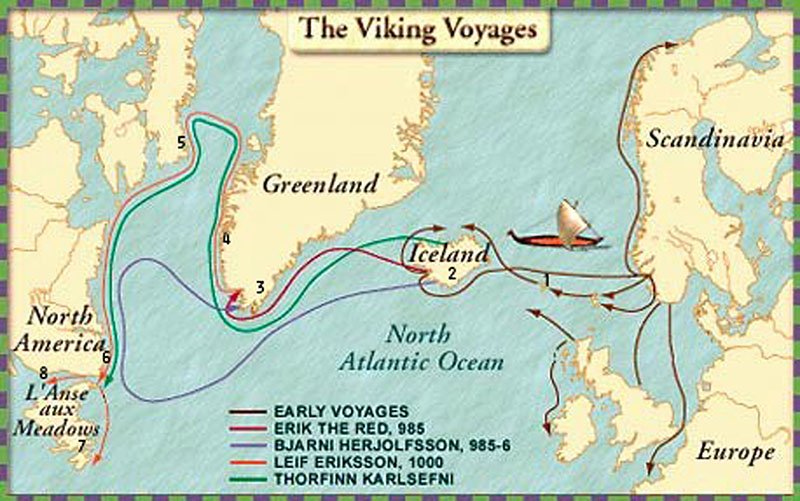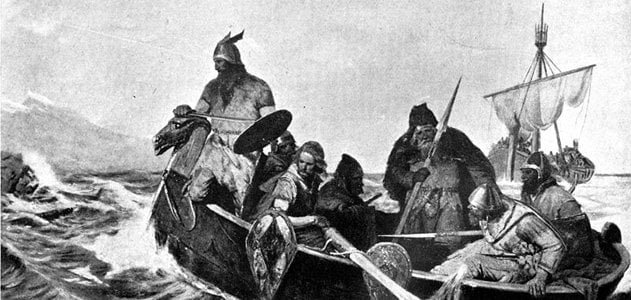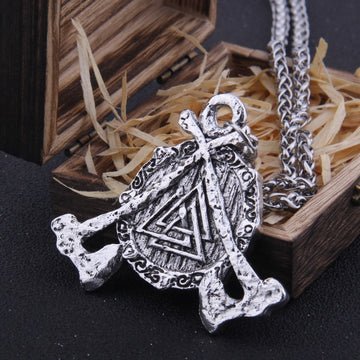Around 900, a ship under the command of Gunnbjörn departed from Norway. He lost his course, and the Vikings saw an island (Greenland). The discovery of Gunnbjörn inspired other Normans on new expeditions. The developer of the Greenland colonies, Eric Red, was expelled from Norway around 985. After a challenging voyage, he managed to find the land found by Gunnbjörn. Its environment was really extreme, but Eric called it Greenland (“Green Country”). In 986, Eric gathered a group of Vikings, ready to settle on the island. When the team showed up, it was summertime, and they managed to establish trade with Scandinavia. Quickly, among the settlers, Bjorny Horlfson, came across an unidentified land, the hills of which were covered with forests (possibly the northeast coast of America) since of the storm. Horlfson was restless to come to Greenland to tell others about his discovery.
The son of Eric, Leif Ericson, was the first Viking to go into the coast of America. Around 1000, he went to the regions he called Helluland (“country of stones”, now Baffin Land ), Markland (“forest country”, Labrador peninsula), and Vinland (“white wine nation”, perhaps New England or Newfoundland ). Erikson’s exploration overwintered in Vinland and went back to Greenland.

Other than those types we had actually the ones called Norsemen that assaulted coastal villages and made pillaging famous.From pillagins to leaving their homeland due to an uncertain overpopulation History.com has the descriptions. History states that,”From around A.D. 800 to the 11th century, a large number of Scandinavians left their homelands to seek their fortunes somewhere else. These seafaring warriors– known collectively as Vikings or Norsemen(” Northmen”)– began by raiding coastal websites, especially undefended abbeys, in the British Isles. Over the next 3 centuries, they would leave their mark as pirates, traders, settlers and raiders
on much of Britain and the European continent, in addition to parts of modern-day Russia, Iceland, Greenland and Newfoundland. The precise factors for Vikings venturing out from their homeland doubt; some have suggested it was because of overpopulation of their homeland, but the earliest Vikings were searching for riches, not land. In the 8th century A.D., Europe was growing richer, sustaining the growth of trading centers such as Dorestad and Quentovic on the Continent and Hamwic(now Southampton), London, Ipswich and York in England. Scandinavian furs were highly treasured in the brand-new trading markets; from their trade with the Europeans, Scandinavians learned about new sailing innovation as well as about the growing wealth and accompanying inner disputes between European kingdoms. The Viking predecessors– pirates who victimized merchant ships in the Baltic Sea– would use this

understanding to expand their fortune-seeking activities into the North Sea and beyond. In A.D. 793, an attack on the Lindisfarne abbey off the coast of Northumberland in northeastern England marked the beginning of the Viking Age. The offenders– probably Norwegians who sailed straight across the North Sea– did not ruin the monastery totally, however the attack shook the European spiritual world to its core. Unlike other groups, these odd new invaders had no regard for religious organizations such as the abbeys, which were frequently left unguarded and susceptible near the shore. Two years later, Viking raids struck the undefended island abbeys of Skye and Iona (in the Hebrides)in addition to
Rathlin(off the northeast coast of Ireland). The very first taped raid in continental Europe can be found in 799, at the island monastery of St Philibert’s on Noirmoutier, near the estuary of the Loire River. “The Vikings have actually left lots of footnotes in history and bigger imprints still as their historic and cultural discovers still add to the greater precision of earths mapping
and ended up being terrific additions to those circumnavigating the world pursuing precision and heritage. WORKS MENTIONED 1. History.com Editors.”Vikings. “History.com, A&E Television Networks, 4 Nov. 2009, https://www.history.com/topics/exploration/vikings-history. 2.” Viking Exploration to America. “About History, 28 Sept. 2021, https://about-history.com/viking-expedition-to-america/.–
–
